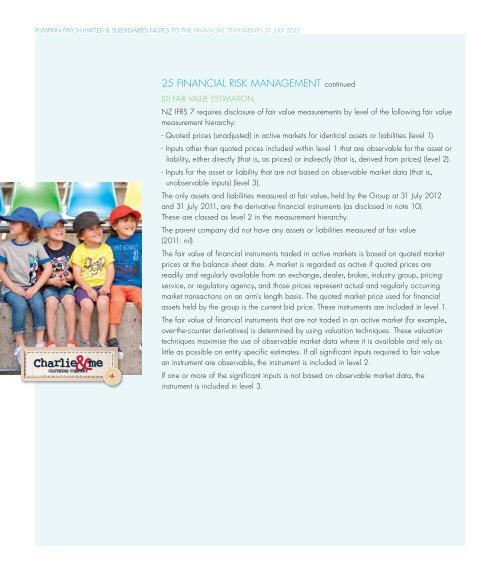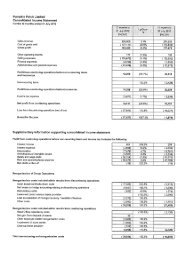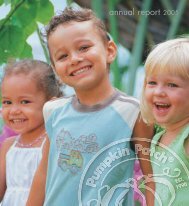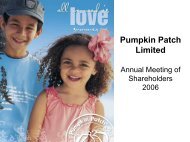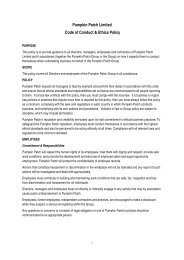annual report 2012 - Pumpkin Patch investor relations
annual report 2012 - Pumpkin Patch investor relations
annual report 2012 - Pumpkin Patch investor relations
- No tags were found...
Create successful ePaper yourself
Turn your PDF publications into a flip-book with our unique Google optimized e-Paper software.
pumpkin patch limited & subsidiaries NOTES TO THE financial statements 31 july <strong>2012</strong>pumpkin patch limited & subsidiaries NOTES TO THE financial statements 31 july <strong>2012</strong>25 Financial risk management continued(d) Fair value estimationNZ IFRS 7 requires disclosure of fair value measurements by level of the following fair valuemeasurement hierarchy:- Quoted prices (unadjusted) in active markets for identical assets or liabilities (level 1).- Inputs other than quoted prices included within level 1 that are observable for the asset orliability, either directly (that is, as prices) or indirectly (that is, derived from prices) (level 2).- Inputs for the asset or liability that are not based on observable market data (that is,unobservable inputs) (level 3).The only assets and liabilities measured at fair value, held by the Group at 31 July <strong>2012</strong>and 31 July 2011, are the derivative financial instruments (as disclosed in note 10).These are classed as level 2 in the measurement hierarchy.The parent company did not have any assets or liabilities measured at fair value(2011: nil)The fair value of financial instruments traded in active markets is based on quoted marketprices at the balance sheet date. A market is regarded as active if quoted prices arereadily and regularly available from an exchange, dealer, broker, industry group, pricingservice, or regulatory agency, and those prices represent actual and regularly occurringmarket transactions on an arm’s length basis. The quoted market price used for financialassets held by the group is the current bid price. These instruments are included in level 1.The fair value of financial instruments that are not traded in an active market (for example,over-the-counter derivatives) is determined by using valuation techniques. These valuationtechniques maximise the use of observable market data where it is available and rely aslittle as possible on entity specific estimates. If all significant inputs required to fair valuean instrument are observable, the instrument is included in level 2.If one or more of the significant inputs is not based on observable market data, theinstrument is included in level 3.25 Financial risk management continued(E) Financial instruments by categoryAssets & liabilities as perbalance sheetLoans andreceivablesDerivativesused forhedgingMeasured atamortised costTotal$’000 $’000 $’000 $’000At 31 July <strong>2012</strong>Cash and cash equivalents 5,343 - - 5,343Trade receivables 7,618 - - 7,618Employee share scheme28 - - 28receivableOther receivables 4,374 - - 4,374Derivative financial- 1,787 - 1,787instrument assetsTrade payables - - (14,944) (14,944)Employee benefits - - (5,696) (5,696)Interest bearing liabilities - - (60,000) (60,000)Derivative financial- (23,183) - (23,183)instrument liabilities17,363 (21,396) (80,640) (84,673)At 31 July 2011Cash and cash equivalents 10,030 - - 10,030Trade receivables 7,554 - - 7,554Employee share scheme100 - - 100receivableOther receivables 2,933 - - 2,933Derivative financial- 5,971 - 5,971instrument assetsTrade payables - - (11,898) (11,898)Employee benefits - - (6,424) (6,424)Interest bearing liabilities - - (71,000) (71,000)Derivative financial- (55,976) - (55,976)instrument liabilities20,617 (50,005) (89,322) (118,710)97


